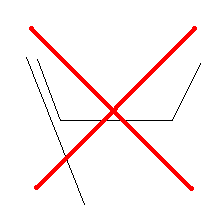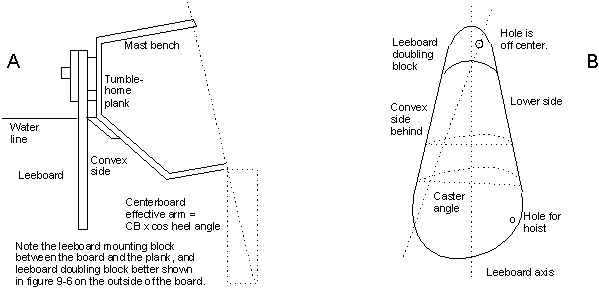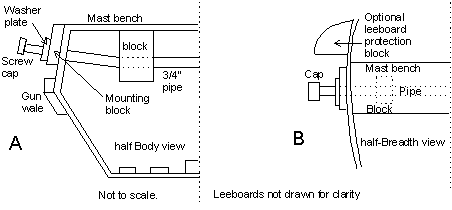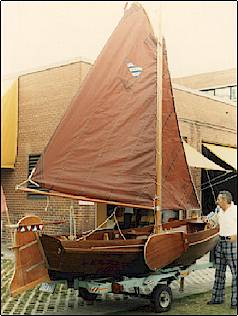|
LEEBOARDS
by Barend Migchelsen Migchelsen@aol.com
https://members.aol.com/_ht_a/migchelsen/myhomepage/
by Barend Migchelsen Migchelsen@aol.com
https://members.aol.com/_ht_a/migchelsen/myhomepage/
The
following is an excerpt from a 6 page booklet written by Barend. For your copy of the
complete booklet, Send $5.00 US ($7.50 cdn.) which includes postage & handling to the
address at right: |
Barend
Migchelsen
1515 Hamilton Place
Dorval QC
H9S 1H3 |
The Dutch did not invent leeboards. They saw them being used in the Far East during their
discovery voyages in the early 1500s.Their merit is that they gave the
boards the curved shape of a light aircraft wing with the thicker edge fore, becoming
thinner toward aft. The convex side of the board is against the hull. The concave side is
on the outside. The lift from the leeboard makes the boat point slightly higher on a tack.
It is very easy to explain with what we know today about aerodynamics. However,
they discovered that 300 years ago without knowing anything about these principles.
For small boats it is not necessary to make the outside concave.
Look at the board as if they are longitudinal cuts from a streamlined
centerboard. The right half is then mounted on the portside of the hull and the left half
at starboard.
|
| The streamlined convex sides are placed against the hull. The
straight (cut) side is on the outside of the leeside. Leeboards never
became popular on the North American continent, mainly because their working is not
properly understood.
A plank against the leeside of a hull does not make a leeboard.
Figure 9-5 is a dangerous no-no. It will give you the least when it is
needed the most! |

Fig. 9 - 5
A dangerous no-no
|
| What every self-respecting, teenage boy can explain to you
about the front wheels of a car, applies identically to leeboards: For optimum performance
the boards must have camber, caster and toe-in.
They are up to 20 percent more effective than a centerboard. It allows for
shorter boards.
They never jam. They are easier to maintain and to repair in case of damage.
Just take them off. Their main advantages are that they eliminate the need for a
centerboard box, which in 90 percent of the cases is the cause of leaks, and leave a
roomy, uncluttered cockpit.
The disadvantages are two extra ropes to handle when tacking, and you have to
be (more) careful when docking.
They also require an extra plank above the sheer. The plank must tumble home
to provide the camber for the boards. See figure 9-6A.
Leeboard Camber
The camber is determined by the inclination of the tumbled-home plank
above the gunwales. You could call the angle of the plank a negative flare angle.
In figure 9-6A it is 9.46 degrees. Tangent of the camber angle is 1/6 = 1.666667.
Maximum effect and efficiency are reached when the hull is sailed with
the gunwale on the waterline, or settled on the gunwale. Then, the board is
vertically down. The flat-bottom sails as a V-bottom.
In this position the leeboard is more effective than a centerboard. The lateral
resistance of the centerboard is equal to the vertical arm of the illustrated centerboard
vector, which is equal to the length of the centerboard x cos heeling angle.
The more heeling, the less resistance when it is needed the most.
It explains why leeboards are 15 to 20 percent
shorter than centerboards.
Leeboard Caster
The hole to hang the leeboard is off center for a smooth sliding action. The caster
angle is not too critical. For a small boat, it is not necessary to hollow the
outside of the board. The convex inside will still give a lifting action toward windward.
See figure 9-6B. |

Fig. 9 - 6 Leeboard camber and caster
| Leeboard Toe-In The toe-in depends on the shape of the hull. It
varies from 0º - 2º as a minimum, to from
0º - 4º as a maximum. In both cases, the maximum value is reached when
the board is fully down. The toe-in decreases when the board is pulled up. At the 45º
angle of the board, the toe-in is 0º. It is not much. But it is the same way with the
front wheels of a car. See the table:
|
| LB position |
Vertical down (90°) |
66-2/3° |
45° |
| 1. Toe-in |
Max. 4° |
2° |
0° |
| 2. Toe-in |
Max. 3° |
1-1/2° |
0° |
| 3. Toe-in |
Max. 2° |
1° |
0° |
| Leeboard Hanging
Heat the ends of a ¾" OD galvanized pipe. Bend the ends to the same angle
as the tumbled-home plank. See figure 9-7A. The pipe is then attached under the mast bench
with wooden blocks. Slide the blocks on the pipe before the heat is applied. Thread the
ends of the pipe to screw on the standard caps. Make the hole in the leeboard big enough
to allow a bit of free play. The pressure of the water holds the board tightly against the
hull. In the half-Breadth view, figure 9-7B, the gunwale is not drawn for clarity.
A metal plate on both sides of the leeboard serves as a washer. Cover plates of
the galvanized, round electric wiring boxes are perfect for this purpose. The hole is
already punch in, and they don’t cost much.
The optional leeboard bumper guard block is at least 1" (actual
¾") thick hardwood. The block is attached at the same height as the pipe.
The leeboard hoist is attached with a stopper knot through a small hole at the
front bottom side of the board as is shown in figure 9-6B. An U-link with the pin through
the hole works also. The photographs show different ways to lead the hoist aft into the
cockpit. |

Fig. 9 - 7 Leeboard hanging

 The
boat in the picture in an original, 14-ft., Frisian Scow. Friesland is the a
northern province of The Netherlands. It was built by a 4th generation builder, and
brought to Canada by me. She is built with 1" African mahogany on white oak
frames. The bottom is TOLA wood. I was told that this is a very tough, oily wood, grown in
Africa. The gaff is a "natural" grown oak branch. The grain follows
the curve of the gaff. You bring the gaff first, to have the sail made. She is rigged
according to the Dutch folklorist rules. The Skybroom, made from black wool is in
top of the mast. (That is another long story.) The red weathervane indicates it is a
pleasure craft. Working boats carry a blue vane. As a matter of curtesy red
always gives way to blue. In Canada, the provincial flag is carried on the bow
sprit, the lands flag on the rudder, preferable on a bent stick so that the tip is just
above the water. In Holland the flag fore would have been a "GEUS", six
red-white-blue triangles. A warship carries a DOUBLE-GEUS, 12 red-white-blue
triangles. The
boat in the picture in an original, 14-ft., Frisian Scow. Friesland is the a
northern province of The Netherlands. It was built by a 4th generation builder, and
brought to Canada by me. She is built with 1" African mahogany on white oak
frames. The bottom is TOLA wood. I was told that this is a very tough, oily wood, grown in
Africa. The gaff is a "natural" grown oak branch. The grain follows
the curve of the gaff. You bring the gaff first, to have the sail made. She is rigged
according to the Dutch folklorist rules. The Skybroom, made from black wool is in
top of the mast. (That is another long story.) The red weathervane indicates it is a
pleasure craft. Working boats carry a blue vane. As a matter of curtesy red
always gives way to blue. In Canada, the provincial flag is carried on the bow
sprit, the lands flag on the rudder, preferable on a bent stick so that the tip is just
above the water. In Holland the flag fore would have been a "GEUS", six
red-white-blue triangles. A warship carries a DOUBLE-GEUS, 12 red-white-blue
triangles. The top of the mast is black, the hardware on
the top, white. The ornament on the barndoor-type rudder is called a
"PRINCE" It is also found on the vertical part of the mast bench. When the boat
became too heavy for me to handle alone, the Dutch Consul in Ottawa bought her. Six
month later, he was transferred to Moscow. She, probably, sails now on the Volga. |

|
![]()